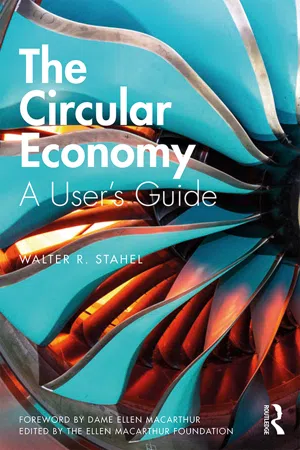
- 102 pages
- English
- ePUB (mobile friendly)
- Available on iOS & Android
About this book
A Circular Economy seeks to rebuild capital, whether this is financial, manufactured, human, social or natural, and offers opportunities and solutions for all organisations. This book, written by Walter Stahel, who is widely recognised as one of the key people who formulated the concept of the Circular Economy, is the perfect introduction for anyone wanting to quickly get up to speed with this vitally important topic for ensuring sustainable development. It sets out a new framework that refines the concept of a Circular Economy and how it can be applied at industrial levels.
This concise book presents the key themes for busy managers and policymakers and some of the newest thinking on the topic of the Circular Economy from one of the leading thinkers in the field. Practical examples and case studies with real-life data are used to elucidate the ideas presented within the book.
Frequently asked questions
- Essential is ideal for learners and professionals who enjoy exploring a wide range of subjects. Access the Essential Library with 800,000+ trusted titles and best-sellers across business, personal growth, and the humanities. Includes unlimited reading time and Standard Read Aloud voice.
- Complete: Perfect for advanced learners and researchers needing full, unrestricted access. Unlock 1.4M+ books across hundreds of subjects, including academic and specialized titles. The Complete Plan also includes advanced features like Premium Read Aloud and Research Assistant.
Please note we cannot support devices running on iOS 13 and Android 7 or earlier. Learn more about using the app.
Information
1 The circular economy, roots and context
1.1 History
| CIRCULARITY | CIRCULAR SOCIETY | INDIVIDUAL CIRCULAR SOCIETY | CIRCULAR INDUSTRIAL ECONOMY (CIE) | |
|---|---|---|---|---|
| TIMELINE | ||||
| STARTED BY | FOREVER | MANKIND | INDUSTRIAL MAN | INDUSTRIAL FIRMS |
| DRIVERS | NATURE | BELIEFS, CULTURE, TRADITION (AMISH) | NECESSITY, GOOD HUSBANDRY | MAINTAINING VALUES, EFFICIENCY IN USE |
| ACTORS | GROUPS | INDIVIDUALS | FLEET MANAGERS | |
| EXAMPLES | WATER CYCLE, CARBON CYCLE | SHARED USE, COMMONS, TRADITIONAL DRESS, PUBLIC LIBRARIES, | SENSE OF CARING, REUSE OF GARMENTS, COLLECTORS’ ITEMS, MAINTENANCE | SERVICE-LIFE EXTENSION, REMANUFACTURING OF GOODS & COMPONENTS, RECOVERING MOLECULES |
| VALUES | IMMATERIAL | NON-MONETARY | PERSONAL | MONETARY |
| IN CONTROL | NATURE | OWNER-USERS | OWNER-USERS | OWNER-MANAGERS |
| CIRCULAR ACTIVITIES | FORESTRY, AGRICULTURE | SHARING SCHEMES | DO-IT-YOURSELF, REPAIR CRAFTSMEN | RENTAL SCHEMES, LEASING, EU RAIL POOL |
| RANGE | GLOBAL | LOCAL | LOCAL | OBJECTS REGIONAL, MOLECULES GLOBAL |
Use it up, wear it out, make it do or do without.
initiatives in science encourage pooling surplus reagents, sharing equipment or keeping better tabs on lab chemicals to avoid duplication. These exercises are about helping science as much as helping the planet. They free up resources that can be applied for scientific purposes.(James 2018)
1.2 The realm of the circular economy
- Industrial ecology is a young science that studies industrial systems with the goal of finding ways to lessen their environmental impact, to learn how industries can use industrial ecology to reduce their consumption of natural resources and generate less waste.1 Thomas Graedel was one of its founders. This concept can be extended to end-of-pipe sectors, such as municipal waste water treatment plants recovering phosphorous, which can be reused as fertiliser.
- Industrial symbiosis is an association between two or more industrial facilities or companies in which the wastes or by-products of one become the raw materials for another, in a linear cascading approach; its lighthouse example is the Kalundborg eco-industrial park. Pure gypsum is a waste product from coal-fired power stations which can be directly used as a resource by plaster board manufacturers instead of natural gypsum. Industrial symbioses is vulnerable to structural change; if plasterboard manufacturers are forced to take back their products, they may give preference to reuse their used products instead of the gypsum waste from power stations.
- Industrial metabolism was proposed by Robert Ayres in analogy to the biological metabolism as ‘the whole integrated collection of physical processes that convert raw materials and energy, plus labour, into finished products and wastes’.
- Cleaner production is a preventive, company-specific environmental protection initiative. It is intended to minimise waste and emissions and maximise product output.
Table of contents
- Cover
- Half Title
- Title Page
- Copyright Page
- Table of Contents
- List of illustrations
- Acknowledgements
- Note from the author
- Foreword
- Introduction
- 1. The circular economy, roots and context
- 2. Circularity, sustainability and labour in the circular industrial economy
- 3. The circular industrial economy, a wealth of new opportunities
- 4. The era of ‘R’: The owner decides locally
- 5. The era of ‘D’: Economic actors recovering resource assets decide
- 6. The point of sale, or factory gate, and liability
- 7. The invisible liability loop, labour and the role of policy
- 8. The Performance Economy, industry adopting the circular industrial economy as default option
- 9. Radical innovation to enhance stock management
- 10. Outlook
- Index